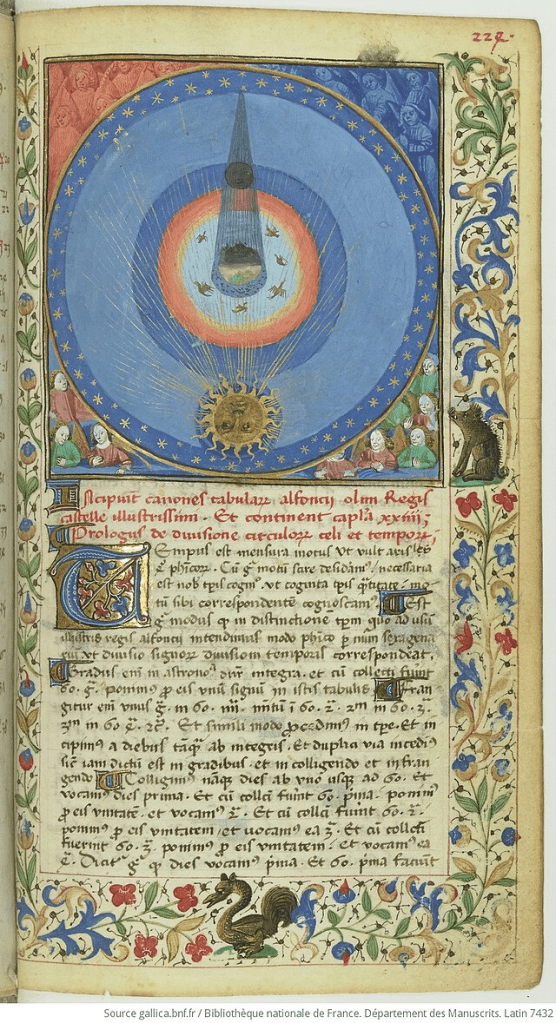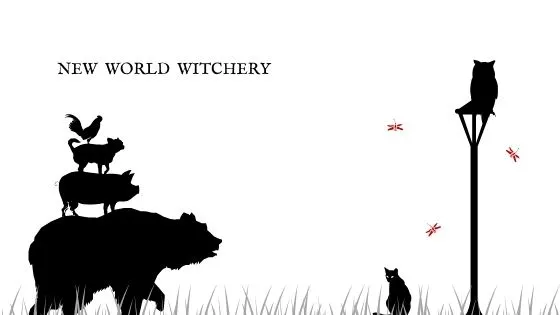
(Image source: Conrad Heingartner (Main), Public domain, via Wikimedia Commons)
On April 8, 2024, contiguous North America will get its last glimpse of a full solar eclipse for twenty years (the next one is due 2044). When we last had the opportunity to glimpse this astronomical wonder in 2017, Laine and I put out an episode focusing on some of the lore and significance of eclipses, and we just released an episode of our Folk Magician’s Notebook that features a lot of eclipse lore as well. We thought it might also be a good idea to compile some of that lore for readers, too, who would be interested in having it to hand as the big day approaches (or just in general out of folkloric curiosity, which is often the best reason to do anything!). So today we’re sharing a few of our favorite tidbits of eclipse-based lore. We should note that much of this material will reference eclipses broadly, so they could be solar or lunar, although we’ll try to be as specific as we can when sources allow. Let’s do some shadow-dancing, then!
Probably the single most pervasive belief about eclipses is that they are portents of some kind. In most cases, they seem to be viewed as fearsome ones, forewarning of doom or calamity of some kind to follow. Biblical prophecies regarding eclipses lean into this, as any Ghostbusters fan knows:
And I beheld when he had opened the sixth seal, and, lo, there was a great earthquake; and the sun became black as sackcloth of hair, and the moon became as blood (Revelation 6:12, KJV)
And when I shall put thee out, I will cover the heaven, and make the stars thereof dark; I will cover the sun with a cloud, and the moon shall not give her light. (Ezekiel 32:7, KJV)
In these contexts eclipses are associated with wrath and judgment and destruction and just generally a bad time had by all. It’s important to note, though, that Christianity hardly has a monopoly on eclipses and doomsaying. According to Joshua Trachtenberg’s book, Jewish Magic and Superstition, the Jewish people also get quite anxious about eclipses: “Eclipses of the moon were taken to be especially ominous for the Jewish people. Eclipses of the sun which occurred on October 26, 1147 and September 4, 1187 threw German Jewry into consternation; later it was learned that on these days German crusaders had suffered serious reverses in Palestine” (pp. 251-52).
One particularly colorful Christian belief about eclipses has to do with a secret planet full of saints:
“There is a planet called Adamida, on which reside the unborn spirits of saints, martyrs and believers. There they remain, awaiting their time to be born into this world. When a martyr is recognized by us, we know that he came from Adamida, the planet of unborn souls. At the crucifixion, Uriel, the angel of the sun, was ordered to interpose this planet between the earth and the sun, thus producing a total eclipse. This is mentioned in the description by the apostles. They say ‘the sun was darkened’”
(Daniels 942).
That may seem like a LOT to derive from a four word biblical passage, but then there has been plenty of ink (and blood) spilled over any number of scriptural excerpts, so a magical planet full of holy people that occasionally blocks out the sun seems somehow almost charming.
Less charming, of course, is the end of the world. Norse mythology features an eclipse event associated with Ragna Rok, or the Doom of the Gods, in the Prose Edda. A volva (seeress) prophecies that as the gods begin to clash with one another, “Then happens what will seem a great miracle, that the wolf devours the sun, and this will seem a great loss. The other wolf will devour the moon, and this too will cause great mischief. The stars shall be hurled from heaven. Then it shall come to pass that the earth and the mountains will shake so violently that trees will be torn up by the roots, the mountains will topple down, and all bonds and fetters will be broken and snapped” (Abridged from the Prose Edda, Penguin Edition, Trans. by Rasmus B. Andersen). As we pointed out during the reading of this passage in our podcast episode, though, the Ragnarok section is immediately followed by a Regeneration section that foresees a renewed earth emerging “green and fair.”

(Image source: Friedrich Wilhelm Heine (1845-1921)., Public domain, via Wikimedia Commons)
Other religions shared this approach, connecting eclipses with mighty powers but not dwelling on them as fearsome. In Islam, a sunnah (saying of the Prophet Muhammad) collected in the third century by an historian named Bukhari noted that the Prophet once said that “The sun and the moon do not eclipse because of the death of someone from the people but they are two signs amongst the signs of Allah. When you see them stand up and pray” (Volume 2, Book 18, Number 151).
Still, in the minds of the folk, eclipses frequently meant one thing: trouble. In the Frank C. Brown Collection of North Carolina Folklore, one entry puts it quite succinctly, saying “When the sun goes into eclipse, it is a sign of some great disaster.” This sentiment gets echoed in folklore collections from Canada to Mexico and back again, although the nature of the disaster is often not specified. In at least one case, an eclipse on 13 April 1140 was taken as a portent that the current king, King Stephen, would soon be removed from rule. An eclipse followed by a “halo” around the sun or moon in the following days was also thought at one time to portend diseases soon to follow (Daniels 941-43).

(Image source: By Ji-Elle – Own work, CC BY-SA 4.0, Wikimedia Commons)
Some of the lore, however, does tie eclipses to specific events, namely weather-related ones:
- An eclipse portends storms (Green Collection, No. 6903)
- An eclipse portends winds (Green Collection, No. 6942)
- An eclipse of the sun is followed by five successive days of rain (Folklore of Adams Co., Illinois No. 35)
In addition to an association with storms, there’s a rather “stormy” character associated with eclipses in North American nautical lore (do eclipses also improve segues? So it seems!). In tales of Alfred Bulltop Stormalong, also known asOld Stormy, a character who was the sailing equivalent to John Henry, the legendary mariner is said to continue working the docks and seas well into the afterlife. According to the Encyclopedia of American Folklore:
Even in the afterlife, Old Stormalong is said to be building ships in the sky, where he carries on his maritime career navigating the heavens rather than the oceans. For this reason, some tales explain that an eclipse is caused by the shadow cast by Old Stormalong’s great ship, and shooting stars occur when they are struck by the movement of Stormalong’s harpoon (Watts)
Leaving aside Old Stormy, what could a person do if an eclipse did seem like a portent of doom to them? Fortunately, numerous cultures came to the same conclusion about what to do: get loud. To forestall any negative eclipse effects, you can beat your pots and pans loudly and shout to scare away anything that might be trying to unleash some wickedness in your home–this is a method used in Ancient Rome, Ancient China, France, Ireland, and Wales. In at least one account of Hindu eclipse beliefs, the text notes that eclipses were a time to give alms to the poor, which would help “relieve the pain which the sun and moon [endure] while being swallowed” (Daniels 943).

(Image source: Joseph Norman Lockyer, Public domain, via Wikimedia Commons)
There are also a few activities that benefit from eclipses. The same source that describes Hindu almsgiving and the pot-and-pan noisemaker methods also says that while starting a lawful enterprise during an eclipse would doom it to failure, starting something illicit would ensure its success. Additionally, beginning a journey during an eclipse (lunar or solar) ensured its success. And finally, you might just get rich if you had the right bouquet on you:
“During an eclipse, all hidden treasures are open, and if you are wise enough to carry a primrose with you, you will be able to help yourself to any of them”
(Daniels 941)
So that’s a brief look at some of the widespread folklore around eclipses. We hope that you’ll go enjoy this year’s celestial obscuring with care and caution, but also a bit of wonder as you think about what they might mean to you as well. And maybe keep a primrose or two handy, just in case there’s some buried treasure nearby.
Thanks for reading!
-Cory
References
- Anderson, Rasmus B. The Prose Edda. Penguin Books/Sacred-Texts, 1936.
- Brown, Frank C. Frank C. Brown Collection of North Carolina Folklore, v. 6, Wayland Hand, ed. Duke Univ. Press, 1964.
- Brown, Frank C. Frank C. Brown Collection of North Carolina Folklore, v. 7, Wayland Hand, ed. Duke Univ. Press, 1964.
- Daniels, Cora Linn. Encyclopedia of Superstitions, Folklore, and the Occult Sciences of the World. Univ. of Michigan Libary, 1903.
- Green, Archie. The Archie Green Collection, 1944-2009. University of North Carolina Archives.
- Hyatt, Henry M. Folklore from Adams County, Illinois. Alma Egan Hyatt Foundation, 1935.
- Trachtenberg, Joshua. Jewish Magic and Superstition. World Publishing Co./Jewish Publication Society of America, 1939.
- Watts, Linda. The Encyclopedia of American Folklore. Facts on File, 2020.

